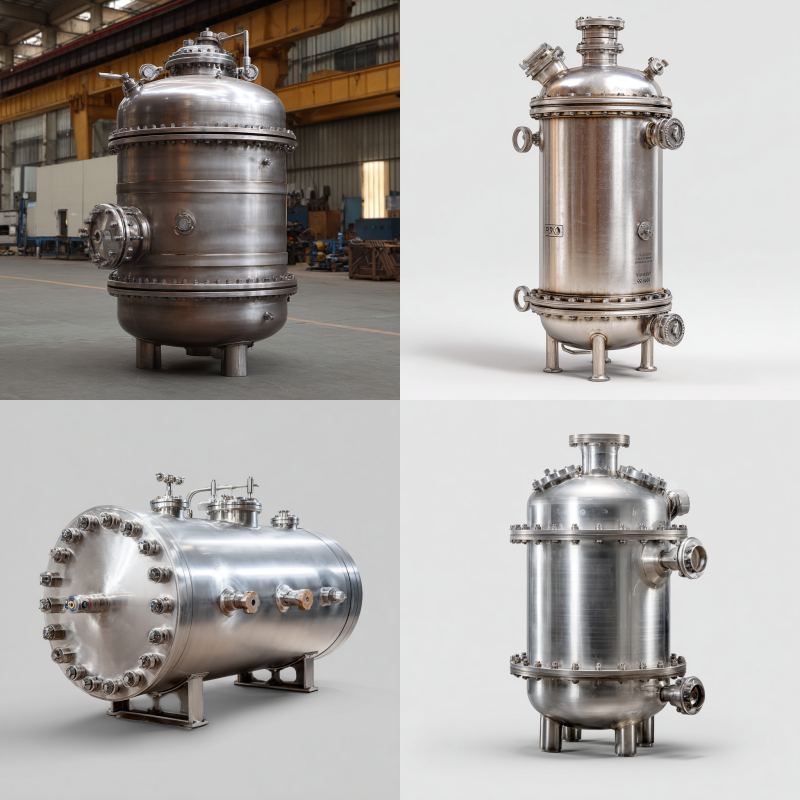
What Materials Are Used in Pressure Vessels?
Understanding What Materials Are Used in Pressure Vessels
When you need to handle gas or liquid under high pressure, you might find yourself wondering what materials are used in pressure vessels, especially if you’re looking for a pressure vessel manufacturer in the USA. Good news, you’re not limited to just one or two choices. Several metals and alloys can stand up to harsh environments while maintaining structural integrity. According to BEPeterson, Titanium, Nickel Alloys, Stainless Steel, Carbon Steel, Aluminum, and Hastelloy rank among the top options. Each one brings unique benefits, whether you value corrosion resistance, cost-effectiveness, ease of fabrication, or a combination of all three. By the end of this guide, you’ll know exactly why these materials matter—and what to consider before making your choice.
What materials are used in pressure vessels
Pressure vessels keep their contents under controlled conditions that differ from normal ambient pressure. They require materials that offer high tensile strength, resistance to cracks, and the ability to handle temperature variations over time. Below is a quick rundown of six commonly used materials. You can also explore more about different vessel categories at types of pressure vessels if you’d like to see how these forms come together in practice.
Titanium: Lightweight yet strong
Titanium weighs about 40 % less than steel but can match or exceed steel’s strength in certain configurations. It also boasts excellent corrosion resistance (particularly against seawater and chlorine-based compounds). As noted by PALA Group, Titanium’s tensile strength can range from 30,000 psi to over 200,000 psi. Because it resists corrosion so effectively, it shines in environments dealing with saltwater or reactive chemicals.
- Advantages: High corrosion resistance, lightweight, strong.
- Drawbacks: Higher cost, more specialized fabrication.
Nickel alloys: Enhanced durability
Nickel alloys (like Monel, Inconel, Hastelloy-family alloys, and Alloy 20) offer outstanding resistance to corrosion and oxidation while remaining structurally robust at high temperatures. BEPeterson confirms that Nickel Alloys often excel where extreme thermal conditions and chemical exposure are present. They can tolerate a wide temperature range, helping your vessel maintain reliability whether you’re dealing with super-hot steam or cryogenic temperatures.
- Advantages: Strong oxidation and corrosion resistance, can endure high and low temperatures.
- Drawbacks: Typically expensive, specialized manufacturing requirements.
Stainless steel: A balanced favorite
Stainless steel is popular for its balance of strength, corrosion resistance, and general availability. PALA Group points out that stainless steels withstand both high and low temperatures without losing robustness. Plus, a stainless-steel vessel can remain rust-free, handle direct sunlight, and resist humidity. This overall resilience often translates to a longer service life and fewer maintenance hassles.
- Advantages: Durable, resists rust, long lifespan, widely available.
- Drawbacks: Heavier than Titanium, cost varies depending on grade.
Carbon steel: Cost-friendly choice
Carbon steel is a go-to material if you need a dependable option at a lower price point. BEPeterson highlights Carbon Steel’s wide use in pressure vessel manufacturing. Its strength can handle typical industrial pressures, and it doesn’t deform easily under stress. On top of that, it’s readily available and can be recycled. Many manufacturers coat or galvanize Carbon Steel to bolster resistance against rust and corrosion.
- Advantages: Low cost, strong, shock-resistant, simple to weld.
- Drawbacks: Lower corrosion resistance if uncoated, heavier than Aluminum or Titanium.
Aluminum: Suitability and trade-offs
Although Aluminum is not always the first choice for extremely high-pressure vessels, certain applications benefit from its lighter weight and decent corrosion resistance. Because it’s easy to machine and transport, Aluminum can be useful for moderate-pressure settings where frequent relocation or quick setup is key. Just be cautious about temperature extremes—Aluminum is more prone to deformation at high temperatures.
- Advantages: Lightweight, easy to form, reasonably corrosion-resistant.
- Drawbacks: Lower melting point, less structural strength compared to steel under very high-pressure or high-temperature conditions.
Hastelloy: Specialized performance
Hastelloy is a Nickel-based alloy, but it’s worth a separate mention because of its strong standing in the chemical and petrochemical industries. BEPeterson points to Hastelloy as a top choice when handling especially corrosive substances, such as in oil and gas or chemical processing. It remains stable over a wide range of temperatures and can handle acidic or oxidative agents without losing integrity.
- Advantages: Outstanding corrosion resistance, high-temperature tolerance, good longevity.
- Drawbacks: Expensive, requires specialized manufacturing techniques.
Consider key selection factors
Selecting the right material for your vessel isn’t just about picking the strongest alloy. It’s about matching the material’s properties to your operating environment, regulatory obligations, and cost constraints. When deciding, you’ll want to think through these key factors.
Temperature and pressure demands
Your vessel could be storing substances at elevated temperatures or under very high pressure. Materials like Nickel Alloys or Stainless Steel often do a better job at withstanding extremes. By contrast, Aluminum might bend or weaken at higher temperatures. Make sure your material can tolerate the operational load through its entire temperature range. LinkedIn highlights that Carbon Steel usually works below 427°C, and for anything higher, you may need steels with additional chromium or molybdenum content.
Corrosion resistance
In chemical plants, marine environments, or anywhere that sees acidic or salty conditions, corrosion can quickly weaken a vessel’s walls. According to Red River, corrosion resistance directly influences longevity and safety. For highly corrosive media, Titanium, Nickel Alloys, or Hastelloy often stand out. For less severe conditions, stainless or carbon steels (with a proper protective coating) can suffice.
Regulatory compliance
In the United States, OSHA sets standards that intersect with how pressure vessels are built or operated, especially around handling flammable or compressed gases. Additional codes, such as those administered by the American Society of Mechanical Engineers (ASME), can guide thickness and material requirements. You can read more on pressure vessel codes and what are pressure vessel codes, which detail how materials are tested, certified, and documented.
Budget and availability
Cost and availability can be the make-or-break factors for many projects. While Titanium or Nickel Alloys may offer top-tier performance, their relative cost is higher than Carbon Steel or standard Stainless Steel. Make sure you factor in both initial investment and long-term maintenance. A cheaper material that requires frequent repairs might cost you more in the long run.
Choose the right material
Beyond pure technical specs, you also want to think practically about your day-to-day operations. With so many materials on the table, it helps to follow a structured approach. You can consult more detailed steps at how to choose materials for pressure vessels. Here’s a quick rundown:
Define pressure and temperature envelope
Start by listing your vessel’s maximum operating pressure and temperature. Include normal operating conditions as well as potential spikes.
Identify chemicals or gases used
The type of fluid matters. For instance, if you’re working with corrosive acids, Titanium or Nickel Alloys might be essential. If it’s standard air storage, Carbon Steel may be enough.
Evaluate corrosion allowances
Even if your fluid isn’t highly acidic, water or humid conditions can lead to gradual corrosion. Decide if you need a protective coating, or if the base metal itself can handle your environment.
Confirm code requirements
Different industries follow different codes, like ASME Section VIII, Divisions 1 and 2. Identify which code your vessel must meet, and ensure the chosen material is allowed under that code.
Predict total lifecycle cost
Material and fabrication costs, protective coatings, potential downtime for repairs—add them up to compare your real costs over the vessel’s lifetime.
Seek expert guidance
Partner with seasoned fabricators or consult specialists. They can point you toward a proven solution, using lessons learned from previous builds.
Choosing Wisely: What materials are used in pressure vessels
By now, you’ve seen how varied and specialized each material can be. From Titanium’s lightweight strength to Carbon Steel’s budget-friendly appeal, you have more than one path to building a robust vessel. The question isn’t just “what materials are used in pressure vessels,” but which option best checks your boxes for cost, corrosion resistance, code compliance, and temperature tolerance. If you choose carefully, you’ll find a solution that stands up to years of pressure without letting you down.
Need a reliable partner?
Red River specializes in the design and manufacturing of pressure vessels. We also fabricate related items such as prefabricated spools and skid packages.
Reach out to us today and experience the Red River difference. Where American-made products and American Values come together, we care more.
Frequently Asked Questions
1. What materials are used in pressure vessels?
Pressure vessels are typically made from high-strength materials that can withstand internal pressure without deformation or rupture. Common options include:
- Carbon steel – cost-effective and widely used for moderate pressure and temperature.
- Stainless steel – excellent corrosion resistance, suitable for food, pharmaceutical, and chemical applications.
- Aluminum – lightweight, corrosion-resistant, but lower strength compared to steel.
- Nickel alloys (e.g., Inconel, Monel) – ideal for high-temperature or highly corrosive environments.
- Composite materials – used in aerospace and specialized applications for weight savings and strength.
2. What is the best material for pressure vessels?
There is no single “best” material —it depends on the operating conditions:
- For general industrial use, carbon steel is a cost-effective choice.
- For corrosive environments or hygienic applications, stainless steel is preferred.
- For extreme temperatures or aggressive chemicals, nickel alloys or specialized metals perform best.
The “best” material balances strength, corrosion resistance, temperature tolerance, and cost for your specific application.
3. How to choose materials for pressure vessels?
Selecting the right material involves evaluating:
- Operating pressure and temperature -higher conditions require stronger, heat-resistant alloys.
- Corrosion resistance -match material to the chemical properties of the stored substance.
- Weight considerations -lightweight composites or aluminum may be needed in aerospace or transport.
- Regulatory compliance -follow ASME, PED, or other applicable codes.
- Budget -balance performance with cost-effectiveness.
A materials engineer or pressure vessel designer should perform a design code-based calculation to ensure safety and compliance.
4. Which materials are best for very high temperatures?
Nickel Alloys, especially Inconel or Hastelloy, often excel in high-temperature conditions. Specialty stainless steels and certain alloy steels can also handle elevated temperatures (above 427°C) without losing strength.
5. How do I maintain a pressure vessel?
Regular inspections are key. Look for signs of cracking, corrosion, or leaks, and clean the vessel to remove scale or buildup. In-depth procedures vary pressure vessel maintenance offers more details on inspections and upkeep.
Key takeaways
- Multiple material choices: Titanium, Nickel Alloys, Stainless Steel, Carbon Steel, Aluminum, and Hastelloy are top contenders.
- Match properties to conditions: Think about temperature ranges, pressure ratings, fluid type, and corrosion risks.
- Follow regulations: ASME and OSHA standards guide how materials must perform in high-pressure environments.
- Mind the budget: More expensive materials may offer better longevity, but weigh lifecycle costs when deciding.
